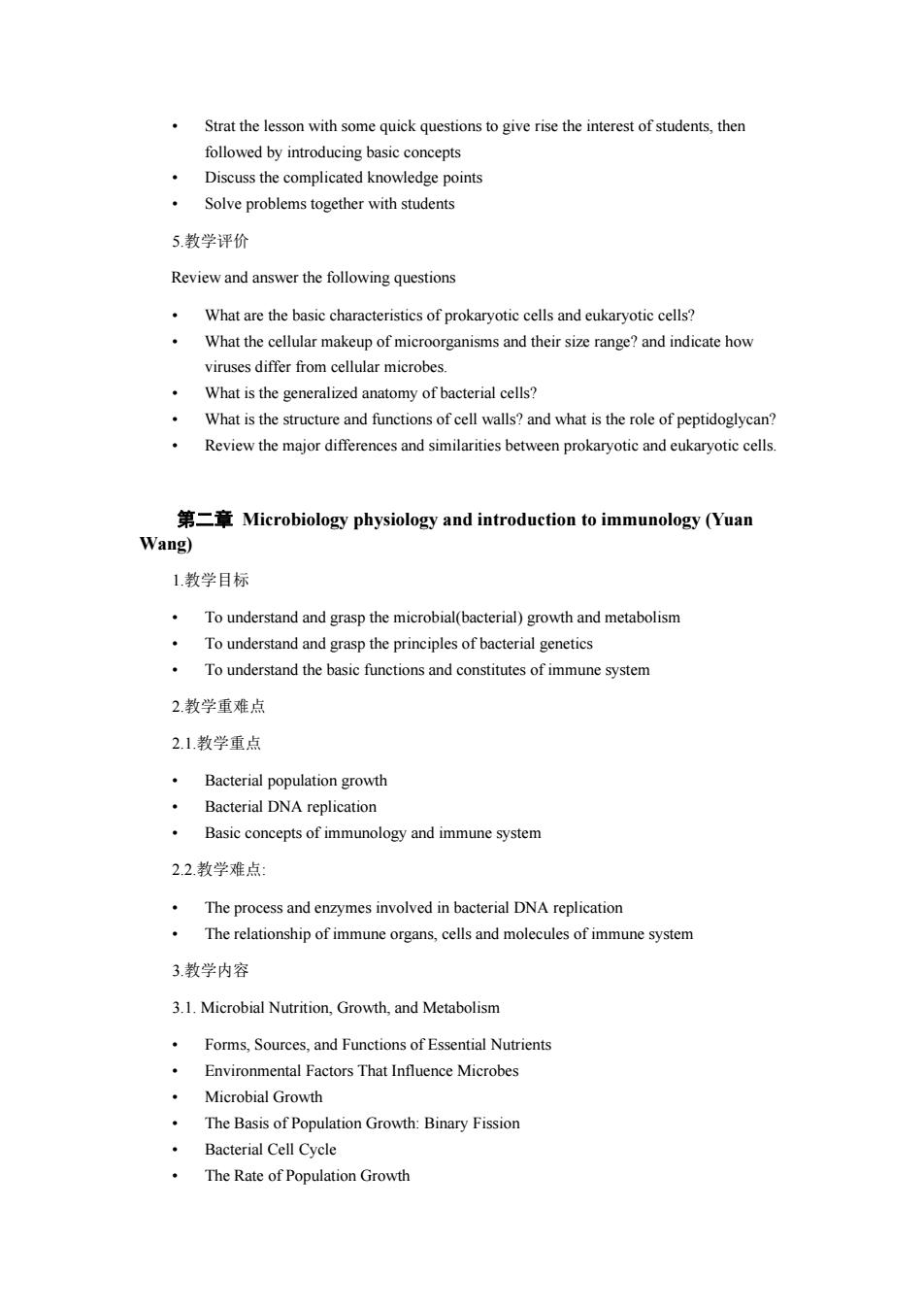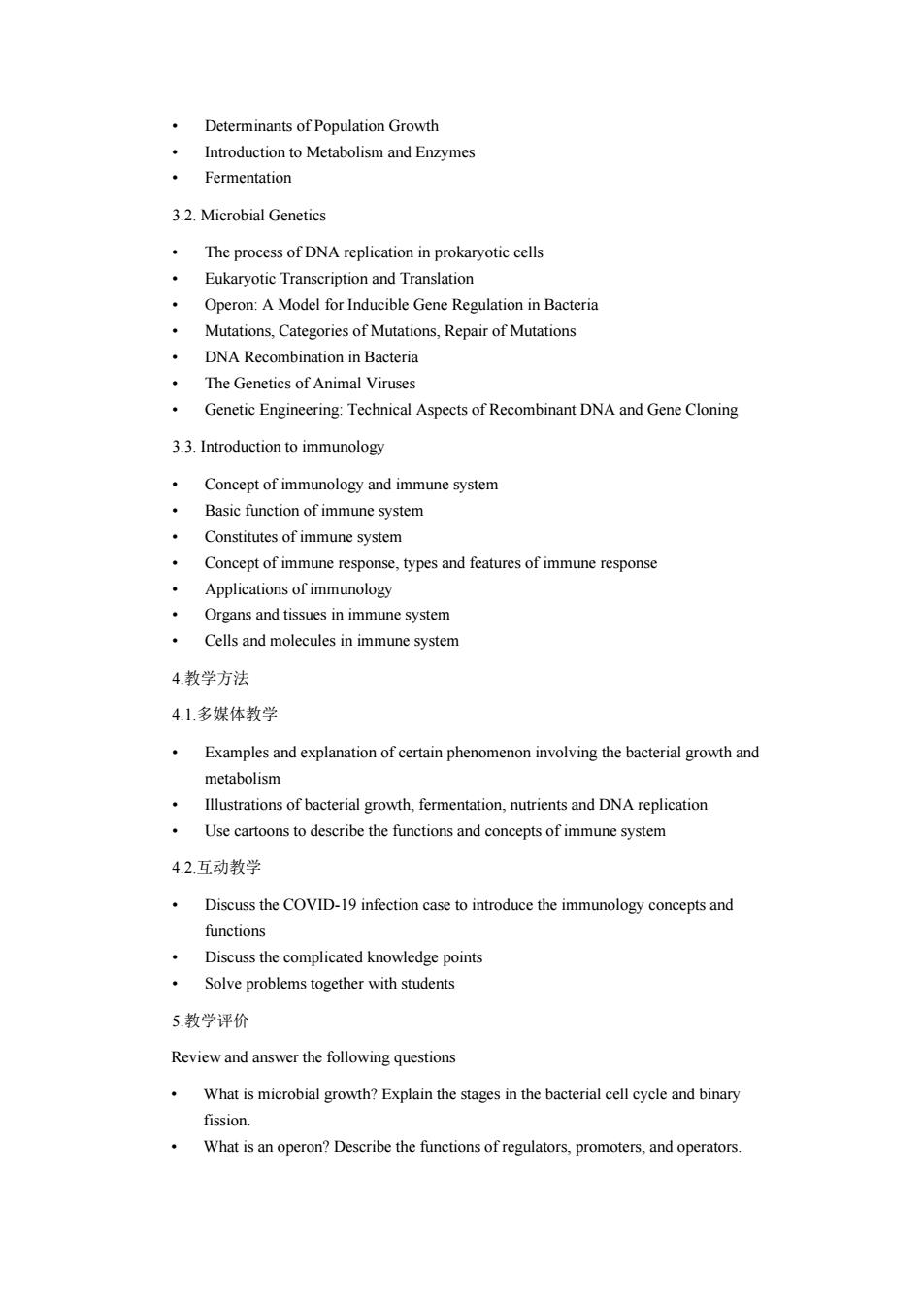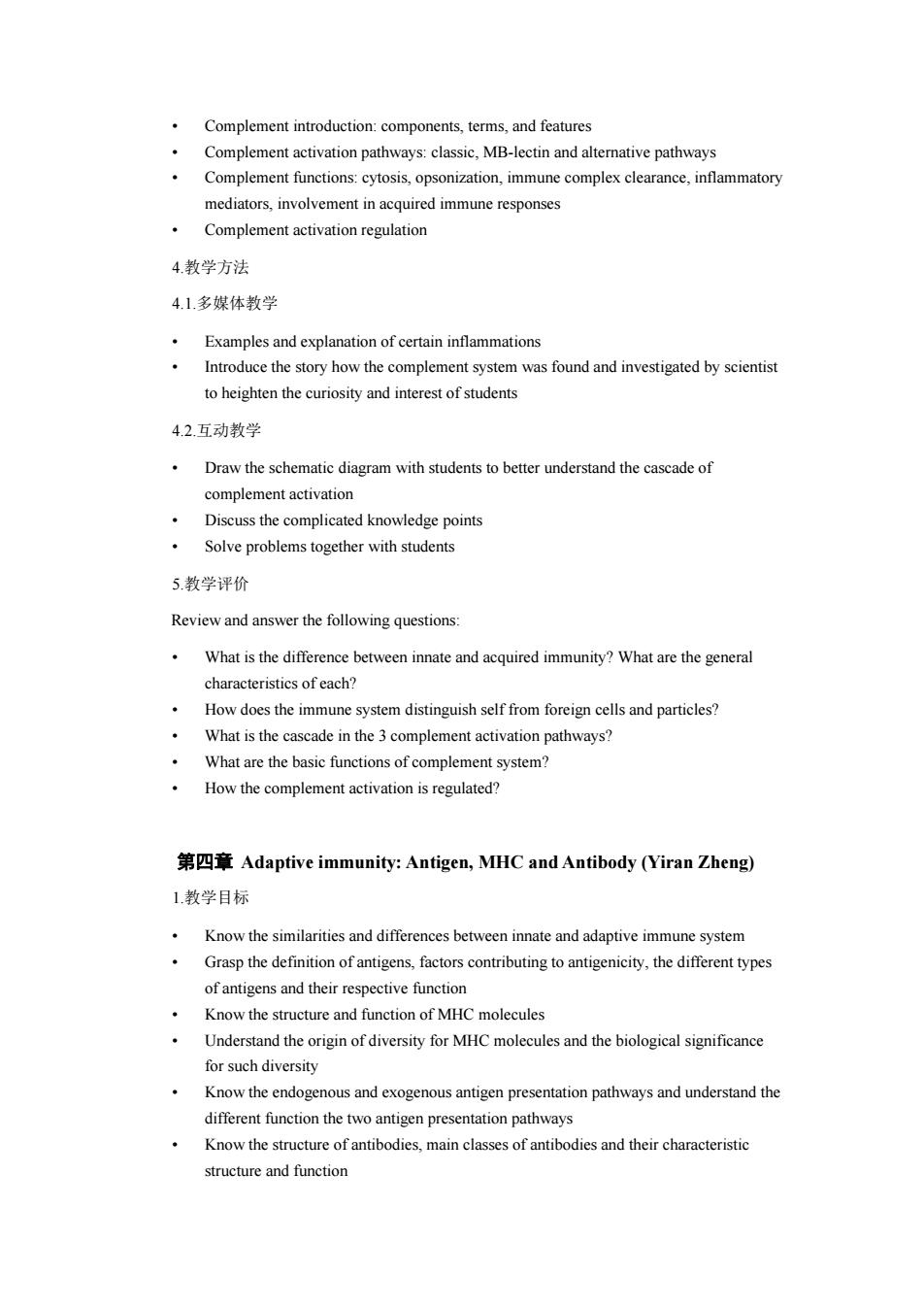
Strat the lesson with some quick questions to give rise the interest of students,then followed by introducing basic concepts Discuss the complicated knowledge points Solve problems together with students 5.教学评价 Review and answer the following questions What are the basic characteristics of prokaryotic cells and eukaryotic cells? What the cellular makeup of microorganisms and their size range?and indicate how viruses differ from cellular microbes. What is the generalized anatomy of bacterial cells? What is the structure and functions of cell walls?and what is the role of peptidoglycan? Review the major differences and similarities between prokaryotic and eukaryotic cells 第二章Microbiology physiology and introduction to immunology(Yuan Wang) 1教学目标 To understand and grasp the microbial(bacterial)growth and metabolism To understand and grasp the principles of bacterial genetics To understand the basic functions and constitutes of immune system 2.教学重难点 2.1.教学重点 Bacterial population growth Bacterial DNA replication Basic concepts of immunology and immune system 2.2.教学难点: The process and enzymes involved in bacterial DNA replication The relationship of immune organs,cells and molecules of immune system 3教学内容 3.1.Microbial Nutrition,Growth,and Metabolism Forms,Sources,and Functions of Essential Nutrients Environmental Factors That Influence Microbes ·Microbial Growth The Basis of Population Growth:Binary Fission Bacterial Cell Cycle The Rate of Population Growth
• Strat the lesson with some quick questions to give rise the interest of students, then followed by introducing basic concepts • Discuss the complicated knowledge points • Solve problems together with students 5.教学评价 Review and answer the following questions • What are the basic characteristics of prokaryotic cells and eukaryotic cells? • What the cellular makeup of microorganisms and their size range? and indicate how viruses differ from cellular microbes. • What is the generalized anatomy of bacterial cells? • What is the structure and functions of cell walls? and what is the role of peptidoglycan? • Review the major differences and similarities between prokaryotic and eukaryotic cells. 第二章 Microbiology physiology and introduction to immunology (Yuan Wang) 1.教学目标 • To understand and grasp the microbial(bacterial) growth and metabolism • To understand and grasp the principles of bacterial genetics • To understand the basic functions and constitutes of immune system 2.教学重难点 2.1.教学重点 • Bacterial population growth • Bacterial DNA replication • Basic concepts of immunology and immune system 2.2.教学难点: • The process and enzymes involved in bacterial DNA replication • The relationship of immune organs, cells and molecules of immune system 3.教学内容 3.1. Microbial Nutrition, Growth, and Metabolism • Forms, Sources, and Functions of Essential Nutrients • Environmental Factors That Influence Microbes • Microbial Growth • The Basis of Population Growth: Binary Fission • Bacterial Cell Cycle • The Rate of Population Growth

Determinants of Population Growth Introduction to Metabolism and Enzymes Fermentation 3.2.Microbial Genetics The process of DNA replication in prokaryotic cells Eukaryotic Transcription and Translation Operon:A Model for Inducible Gene Regulation in Bacteria Mutations,Categories of Mutations,Repair of Mutations DNA Recombination in Bacteria The Genetics of Animal Viruses Genetic Engineering:Technical Aspects of Recombinant DNA and Gene Cloning 3.3.Introduction to immunology Concept of immunology and immune system Basic function of immune system Constitutes of immune system Concept of immune response,types and features of immune response Applications of immunology Organs and tissues in immune system Cells and molecules in immune system 4.教学方法 4.1.多媒体教学 Examples and explanation of certain phenomenon involving the bacterial growth and metabolism Illustrations of bacterial growth,fermentation,nutrients and DNA replication Use cartoons to describe the functions and concepts of immune system 4.2.互动教学 Discuss the COVID-19 infection case to introduce the immunology concepts and functions Discuss the complicated knowledge points Solve problems together with students 5.教学评价 Review and answer the following questions What is microbial growth?Explain the stages in the bacterial cell cycle and binary fission. What is an operon?Describe the functions of regulators,promoters,and operators
• Determinants of Population Growth • Introduction to Metabolism and Enzymes • Fermentation 3.2. Microbial Genetics • The process of DNA replication in prokaryotic cells • Eukaryotic Transcription and Translation • Operon: A Model for Inducible Gene Regulation in Bacteria • Mutations, Categories of Mutations, Repair of Mutations • DNA Recombination in Bacteria • The Genetics of Animal Viruses • Genetic Engineering: Technical Aspects of Recombinant DNA and Gene Cloning 3.3. Introduction to immunology • Concept of immunology and immune system • Basic function of immune system • Constitutes of immune system • Concept of immune response, types and features of immune response • Applications of immunology • Organs and tissues in immune system • Cells and molecules in immune system 4.教学方法 4.1.多媒体教学 • Examples and explanation of certain phenomenon involving the bacterial growth and metabolism • Illustrations of bacterial growth, fermentation, nutrients and DNA replication • Use cartoons to describe the functions and concepts of immune system 4.2.互动教学 • Discuss the COVID-19 infection case to introduce the immunology concepts and functions • Discuss the complicated knowledge points • Solve problems together with students 5.教学评价 Review and answer the following questions • What is microbial growth? Explain the stages in the bacterial cell cycle and binary fission. • What is an operon? Describe the functions of regulators, promoters, and operators

Compare conjugation,transformation,and transduction on the basis of general method, donor,and recipient. What is the basic function of immune system? Can you list the important molecules which play function in immune responses?And can you differentiate them which are cell surface molecules and which of them are secreted proteins? 第三章Innate immunity(Yuan Wang) 1.教学目标 To understand the principles of host defense and immune responses To understand the process and functions of innate immunity(inflammation, phagocytosis,interferons) To understand and grasp the function and mechanism of complement system 2教学重难点 2.1.教学重点 3 activation pathways of complement system Functions of complement system 2.2.教学难点 The procedures of complement activation The regulation mechanisms of complement activation 3教学内容 3.1.Introduction to host defense and innate immunity The characteristics of basic host defenses Introduction of three lines of host defense First line of host defense:different barriers'components,structure and functions Introduction of innate and acquired immunity The organs,tissues and cells'in innate immune system Leukocytes'functions and mechanism in innate immunity 3.2.Innate immunity-Inflammation,Phagocytosis,Interferon The Inflammatory Response and its features The process and stages of Inflammation Inflammatory Mediators,their functions and mechanisms Phagocytosis:Phagocytes,Phases Interferon:Types,roles and mechanisms 3.3.Innate immunity-Complement
• Compare conjugation, transformation, and transduction on the basis of general method, donor, and recipient. • What is the basic function of immune system? • Can you list the important molecules which play function in immune responses? And can you differentiate them which are cell surface molecules and which of them are secreted proteins? 第三章 Innate immunity (Yuan Wang) 1.教学目标 • To understand the principles of host defense and immune responses • To understand the process and functions of innate immunity (inflammation, phagocytosis, interferons) • To understand and grasp the function and mechanism of complement system 2.教学重难点 2.1.教学重点 • 3 activation pathways of complement system • Functions of complement system 2.2.教学难点 • The procedures of complement activation • The regulation mechanisms of complement activation 3.教学内容 3.1. Introduction to host defense and innate immunity • The characteristics of basic host defenses • Introduction of three lines of host defense • First line of host defense: different barriers’ components, structure and functions • Introduction of innate and acquired immunity • The organs, tissues and cells’ in innate immune system • Leukocytes’ functions and mechanism in innate immunity 3.2. Innate immunity-Inflammation, Phagocytosis, Interferon • The Inflammatory Response and its features • The process and stages of Inflammation • Inflammatory Mediators, their functions and mechanisms • Phagocytosis: Phagocytes, Phases • Interferon: Types, roles and mechanisms 3.3. Innate immunity-Complement

Complement introduction:components,terms,and features Complement activation pathways:classic,MB-lectin and alternative pathways Complement functions:cytosis,opsonization,immune complex clearance,inflammatory mediators,involvement in acquired immune responses Complement activation regulation 4教学方法 4.1.多媒体教学 Examples and explanation of certain inflammations Introduce the story how the complement system was found and investigated by scientist to heighten the curiosity and interest of students 4.2.互动教学 Draw the schematic diagram with students to better understand the cascade of complement activation Discuss the complicated knowledge points Solve problems together with students 5教学评价 Review and answer the following questions: What is the difference between innate and acquired immunity?What are the general characteristics of each? How does the immune system distinguish self from foreign cells and particles? What is the cascade in the 3 complement activation pathways? What are the basic functions of complement system? How the complement activation is regulated? 第四章Adaptive immunity:Antigen,.MHC and Antibody(Yiran Zheng) 1.教学目标 Know the similarities and differences between innate and adaptive immune system Grasp the definition of antigens,factors contributing to antigenicity,the different types of antigens and their respective function Know the structure and function of MHC molecules Understand the origin of diversity for MHC molecules and the biological significance for such diversity Know the endogenous and exogenous antigen presentation pathways and understand the different function the two antigen presentation pathways Know the structure of antibodies.main classes of antibodies and their characteristic structure and function
• Complement introduction: components, terms, and features • Complement activation pathways: classic, MB-lectin and alternative pathways • Complement functions: cytosis, opsonization, immune complex clearance, inflammatory mediators, involvement in acquired immune responses • Complement activation regulation 4.教学方法 4.1.多媒体教学 • Examples and explanation of certain inflammations • Introduce the story how the complement system was found and investigated by scientist to heighten the curiosity and interest of students 4.2.互动教学 • Draw the schematic diagram with students to better understand the cascade of complement activation • Discuss the complicated knowledge points • Solve problems together with students 5.教学评价 Review and answer the following questions: • What is the difference between innate and acquired immunity? What are the general characteristics of each? • How does the immune system distinguish self from foreign cells and particles? • What is the cascade in the 3 complement activation pathways? • What are the basic functions of complement system? • How the complement activation is regulated? 第四章 Adaptive immunity: Antigen, MHC and Antibody (Yiran Zheng) 1.教学目标 • Know the similarities and differences between innate and adaptive immune system • Grasp the definition of antigens, factors contributing to antigenicity, the different types of antigens and their respective function • Know the structure and function of MHC molecules • Understand the origin of diversity for MHC molecules and the biological significance for such diversity • Know the endogenous and exogenous antigen presentation pathways and understand the different function the two antigen presentation pathways • Know the structure of antibodies, main classes of antibodies and their characteristic structure and function

2教学重难点 The difference between innate and adaptive immune system and why we need both systems The structural and functional difference between MHC class I and class II molecules The characteristic structure and function of the five main classes of antibodies 3.教学内容 3.1.Overview of adaptive immunity Similarities and differences between innate and adaptive immune system 3.2.Antigens and antigenicity Definitions of antigen,antigenicity,immunogen,immunogenicity and epitope The origin of antigens Factors affecting antigenicity (size,complexity and molecular shape)and their applications in inducing immune responses The structure and function of different types of antigens such as hapten,alloantigen, superantigen,allergen and autoantigen 3.3.The Major Histocompatibility Complex(MHC)and antigen presentation Structure and function of MHC Class I and Class II molecules Expression pattern of MHC molecules The origin of diversity of MHC molecules Antigen presenting cells The endogenous pathway of antigen processing and presentation The exogenous pathway of antigen processing and presentation 3.4.Antibody The structure of antibodies (light chains,heavy chains,complementarity-determining region) The structure.function.distribution and relative abundance of the five major classes of antibodies(IgG,IgA,IgM,IgD,IgE) 4.教学方法 4.1.Multimedia PowerPoint slides for content display Video clip about adaptive immune system Video clip about antibody structure 4.2.Teacher-student interaction On-screen multiple-choices quiz at the end of each section during the class Discussion about the roles of MHC molecules the potential outcome during a virus pandemic 5.教学评价 课后问题
2.教学重难点 • The difference between innate and adaptive immune system and why we need both systems • The structural and functional difference between MHC class I and class II molecules • The characteristic structure and function of the five main classes of antibodies 3.教学内容 3.1. Overview of adaptive immunity • Similarities and differences between innate and adaptive immune system 3.2. Antigens and antigenicity • Definitions of antigen, antigenicity, immunogen, immunogenicity and epitope • The origin of antigens • Factors affecting antigenicity (size, complexity and molecular shape) and their applications in inducing immune responses • The structure and function of different types of antigens such as hapten, alloantigen, superantigen, allergen and autoantigen 3.3. The Major Histocompatibility Complex (MHC) and antigen presentation • Structure and function of MHC Class I and Class II molecules • Expression pattern of MHC molecules • The origin of diversity of MHC molecules • Antigen presenting cells • The endogenous pathway of antigen processing and presentation • The exogenous pathway of antigen processing and presentation 3.4. Antibody • The structure of antibodies (light chains, heavy chains, complementarity-determining region) • The structure, function, distribution and relative abundance of the five major classes of antibodies (IgG, IgA, IgM, IgD, IgE) 4.教学方法 4.1. Multimedia • PowerPoint slides for content display • Video clip about adaptive immune system • Video clip about antibody structure 4.2. Teacher-student interaction • On-screen multiple-choices quiz at the end of each section during the class • Discussion about the roles of MHC molecules the potential outcome during a virus pandemic 5.教学评价 课后问题